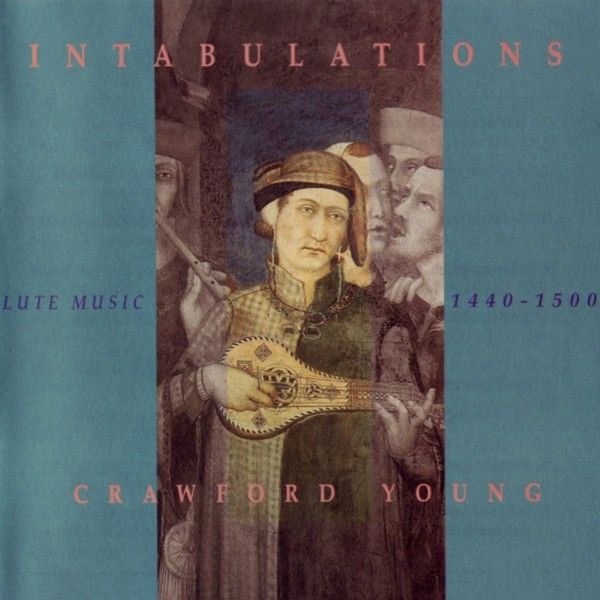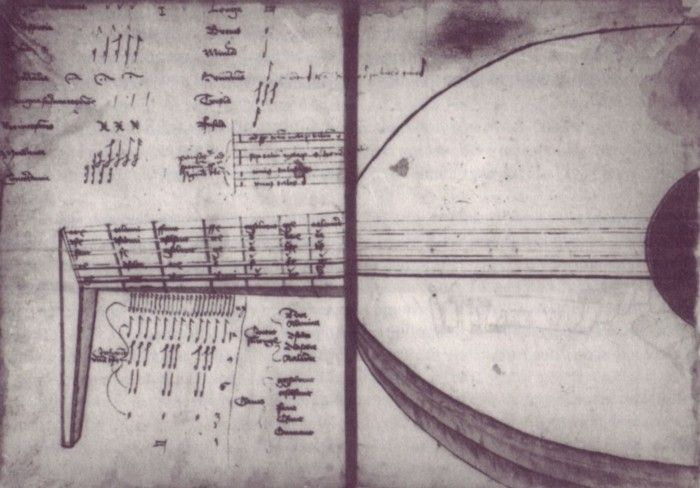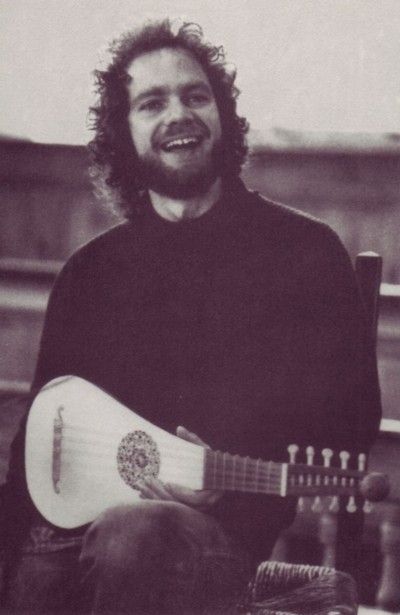Intabulations / Crawford Young
Lute Music • 1440 - 1500

medieval.org
Lantefana CD 94101
1995
1. La belle et la gente rose [3:18]
Anonymous (ca. 1415) — Turin, Bibl. Nac., Ms. J.ii.9
2. Et videar invidorum [3:50]
Ugolino d'ORVIETO (ca. 1380=1457) — Rome, Bibl. Casanatense, Ms. c ii, 3
3. Ile fantazies de Joskin [2:43]
JOSQUIN (ca. 1480) — Rome, Bibl. Casanatense, Ms. 2856
4. Scaramella fa la galle [2:37]
Loyset COMPÈRE (ca. 1445-1518) / C. Young — Florence, Bil. del Conservatorio, Ms. 2439
5. Textless ballade [2:25]
Walter FRYE (?) (ca. 1460) — Prague, Pamatník Narodního Písemnictví, Strahovska Knihovna, Ms. D.G. iv. 47
6. Tandernacken [1:32]
Crawford YOUNG
7. Va-t'en regrets [2:00]
Loyset COMPÈRE (ca. 1445-1518) — Brussels, Bibl. royal, Ms. 228
8. Amour en un beau vergier [3:30]
Anonymous (ca. 1415) — Turin, Bibl. Nac., Ms. J.ii.9
9. Bekenne myn klag, pulcherissima de virgine [1:57]
Anonymous (ca. 1460) — Munich, Bayrische Staatsbibliothek, Mus. ms. 3725
10. Mit ganczem willen wünsch ich dir [3:44]
Anonymous (ca. 1450-55) — Berlin, Deutsche Staatsbibliothek, Mus. ms. 40613
11. Ballo Verçeppe [4:17]
Domenico de PIACENZA (before 1455) — Paris, Bibl. Nat., fons. ital. 972
12. Wann ich betracht die Vasenacht [3:16]
Anonymous (ca. 1460) — Munich, Bayrische Staatsbibliothek, Mus. ms. 3725
13. Le serviteur hault guerdonné [3:45]
Anonymous (1509) — Perugia, Bibl. Comunale Augusta, Ms. 1013
14. Tandernack [3:16]
Antoine BRUMEL (ca. 1460-ca. 1515) — Vienna, Österreichische Nationalbibliothek, Ms. 18810
15. Cecus non judicat de coloribus [6:10]
Alexander AGRICOLA (ca. 1446-1506) — Segovia, Archivo Capitular de la Catedral, Ms. without shelf mark

Crawford Young — lute
Michael Craddock — lute
Shira Kammen — vielle
Ralf Mattes — hackbrett
Recorded at Römisch-Katholische Kirche Seewen (CH),
and the Music Room, Cambridge, Mass. (1993)
Engineer: Joel Gordon
Editing: Joel Gordon, Götz Bürki
All arrangements by Crawford Young
Front cover: St. Martin's Investiture by Simone Martini, Basilica S. Francesco, Assisi
Page 16: from 2° Ms. math. 31, Murhardsche Bibliothek, Kassel
Back: photo by Bob Shamis
Special thanks to Stefan, Joel, Shira, Michael, Götz and Ralf
Instruments:
5 -course lute in g / Joel van Lennep 1982
6 -course lute in e / Joel van Lennep 1993
6 -course lute in a / Richard Earle 1992
6 -course lute in g / Lawrence Brown 1989
6 -course lute in e / Daniel Larsen 1989
vielle / Fabrizio Reginato 1984
hackbrett after Virdung / Nicholas Blanton 1985
© Ⓟ 1995 LANTEFANA
Germany
English liner notes

The
Während die Lautenmusik des 16.Jahrhunderts, auch aufgrund unzähliger
Schallplatteneinspielungen, heute allgemein bekannt ist kann man dies
von der Lautenmusik des 15. Jahrhunderts nicht behaupten. In heutigen
Aufführungen mit Musik aus dieser Zeit wird die Laute fast
ausschließlich als Ensembleinstrument verwandt. Der Hauptgrund hierfür
ist sicherlich das Fehlen jeglicher schriftlicher Aufzeichnungen der
Musik für dieses Instrument vor dem Ende des 15. Jahrhunderts. Neben
vielen bildlichen Belegen geben uns schriftliche Dokumente — von der
Erzählung bis zum höfischen Rechnungsbuch — Hinweise darauf, daß wir aus
diesem Mangel an primären Quellen nicht auf das Fehlen eines
Repertoires schliessen dürfen. Die hier vorliegende CD versucht ein
solches mögliches Repertoire zu rekonstruieren. Dabei ist der Titel ‘Intabulations’
durchaus programmatisch zu verstehen, handelt es sich doch bei solchen
um eine der Hauptformen der Lautenmusik des 16. Jahrhunderts. Die
vorliegende Aufnahme versucht, die um die Jahrhundertwende relativ
unvermittelt auftretenden Traditionsstränge über die Grenzen der
Schriftlichkeit hinweg zurückzuverfolgen um einen Einblick zu geben in
die Musik, die von den berühmten Lautenisten des 15. Jahrhunderts
gespielt wurde.
Die Laute erfuhr im 15. Jahrhundert mehrere
wesentliche bau- und spieltechnische Veränderungen. Einerseits erhielt
das Instrument Anfang des Jahrhunderts die schon von kleineren
Zupfinstrumenten bekannten Bünde, zum andererseits entwickelte sich
neben der Spielweise mit dem Plectrum die Fingertechnik, wobei es
wahrscheinlich viele Zwischenformen gab. Es ist wichtig zu betonen, daß
die Plectrumtechnik keinesfalls nur einstimmiges Spiel zuließ, vielmehr
kann auch mit dem dem Plectrum ein polyphoner Satz klar dargestellt
werden, auch wenn dies in der heutigen Literatur häufig verkannt wird.
Wer
spielte nun im 15. Jhd. Laute? In erster Linie waren dies sicherlich
professionelle Spielleute, wobei man sich jedoch vom romantisch
geprägten Bild des illiteraten, fahrenden Musikers lösen muß. Die ‘Menestrells’
von denen hier die Rede ist gehörten zu einer Gruppe von Musikern denen
es im Laufe des 14. Jhd. gelang, sich in Bruderschafen zu organisieren
und somit einen Platz in der mittelalterlichen Ständegesellschaft zu
finden. Als Städter besaßen sie durchaus Schreib- und Lesekenntnisse,
und schon die frühesten Aufzeichnungen instrumentaler Musik zeigen
grundlegende Kenntnisse der vokalen Satztechnik. Wie wir aus vorhandenen
Dokumenten wissen beherrschten viele dieser Musiker mehr als ein
Instrument. Der berühmte Organist Konrad Paumann wurde auch für sein
Können auf der Laute gepriesen, und neuentdeckte Quellen lassen auf eine
enge Verbindung zwischen dem Repertoire für Laute und dem für Orgel
schliessen. Auch ist von einigen Komponisten des frühen 15. Jhd.
bekannt, daß sie auch als Instrumentalisten tätig waren, so z.Bsp. Baude
Cordier, Jacob Senleches und Rodriguet de la guitarra. Neben diesen
professionellen Musikern finden sich im Lauf des Jahrhunderts mehr und
mehr Belege häuslichen Musizierens, welches dann im frühen
16.Jahrhundert zu den didaktischen Veröffentlichungen Virdungs,
Jundenkünigs und anderer führte.
Die Stücke dieser Aufnahme
versuchen, einen repräsentativen Querschnitt durch die Lautenmusik des
15. Jhd. zu geben. Ein Schwerpunkt liegt hierbei auf den sogenannten ‘Intabulierungen’, d.h. instrumentalen Bearbeitungen vokaler Vorlagen. Das Wort intabulieren
bezieht sich auf den Vorgang des Arrangierens mehrerer Stimmen in einem
großen Notensystem. Durch einen glücklichen Zufall besitzen wir eine
solche Tabula eines Stückes von Guillame DuFay. Dies ist jedoch
nur der erste Schritt der Bearbeitung; Je nach Stil und technischen
Fähigkeiten des Intabulators konnte noch in einer oder mehreren Stimmen
Verzierungen hinzutreten oder aber freie Zwischenspiele, sogenannte Pausae eingefügt werden. Über diese Techniken sind wir — nicht zuletzt durch Konrad Paumannns umfangreiches ‘Fundamendum Organisandi’
— recht gut informiert. Eine andere Möglichkeit bestand darin, nur eine
Stimme der Vokalkomposition zu übernehmen. Gegen diese, meist den Tenor,
wurde dann eine oder zwei kunstvolle Stimmen gesetzt. Diese Technik der
Bearbeitung lässt sich auf zwei Traditionen zurückführen, einerseits
der Improvisation ‘super Librum’,
d.h. der Improvisation über einen gegebenen (liturgischen) Tenor,
andererseits auf die improvisierte Ausführung der ‘Basse Danse’.
Eine solche Satztechnik wurde auch von Tinctoris in seinen Schriften
über musikalische Proportionen gelehrt. Gegen einen in langsamen
Notenwerten fortschreitende, vorgegebene Stimme spielt die zweite einen
Kontrapunkt, der die möglichen Proportionen, d.h. die rhythmischen
Verhältnisse zweier Stimmen, durchläuft. Hierbei handelt es sich, im
Gegensatz zu den zum Tanzen bestimmten Basse Danse um ‘absolute’, d.h. nicht funktional gebunden Musik.
Aus
kompositorischen Überlegungen heraus sind die Stücke des frühen 15.
Jahrhunderts weniger ‘wörtliche’ Übertragungen als die meisten
Bearbeitungen späterer Stücke. ‘La belle e la gente rose’ aus dem
Manuskript Turin enthält ein freies Zwischenspiel, welches sich
stilistisch an das zeitgleiche Manuskript Faenza, das instrumentale
Bearbeitungen vokaler Vorlagen enthält, anlehnt. ‘Et videar invidorum’
ist eine Vokalkomposition Ugolinos d'Orvietos die die
Proportionskompositionen Tinctoris vorwegnimmt. Hier wie in ‘Le serviteur hault guerdonné’ spielt die Laute einen melodisch und rhythmisch komplexen Kontrapunkt gegen die vorgegebene Stimme. Diese ist in ‘Et videar invidorum’ der Tenor, in ‘Le serviteur’ der Superius des ursprünglichen Vokalwerks.
Man
kann davon ausgehen, daß die Lautenisten des 15. Jhd., wie ihre
Nachfolger in spätere Zeit, gerne besonders populäre Stücke als Vorlagen
auswählten, und so folgen, wie in der Vokalmusik, auf die Balladen des
Jahrhundertanfangs sehr bald Rondeaux. ‘Scaramella’ ist ein
typisches Beispiel für ein weitverbreitete Melodie — nicht nur liegt es
in mehreren vokalen Fassungen vor, welche wiederum im 16. Jhd. für Laute
intabuliert wurden, wir wissen auch, daß der berühmte Hoflautenist am
Hof des Borso d'Este in Ferrara, Pietrobono del Chitarino, zumindest
zwei Fassungen dieses Stückes in seinem Repertoire hatte. Leider sind
uns seine Bearbeitungen nicht überliefert, vielleicht auch, weil er, wie
wir aus einem Brief seines Schülers Don Acteon schliessen dürfen, nicht
all seine Kunst weitergeben wollte.
Ganz anders ist die
Situation bei den Stücken aus deutschen Orgelquellen. Hier liegt uns ein
großes Repertoire aus dem Umfeld Konrad Paumanns vor. Für uns von
besonderem Interesse ist Paumanns didaktisches Werk, das ‘Fundamentum Organisandi’,
aus dem wir erfahren, wie ein deutscher Organist im 15. Jhd. Vorlagen
bearbeitete. Hierbei konnte er entweder das Original übernehmen und
auszieren, oder den Tenor der Komposition mit neuen Gegenstimmen
versehen, sowie Zwischen— und Nachspiele einfügen. Da Paumann, wie die
meisten seiner Kollegen, mehrere Instrumente beherrschte können wir
davon ausgehen, daß vieles aus dieser Unterweisung auch für die Laute
Gültigkeit hat.
Aus den späten 15. Jhd. stammen unsere frühsten
Quellen für instrumentale Ensemblemusik. Das Josquin de Prez
zugeschriebene Stück ‘Ile fantazies...’ ist nur in einer Quelle
überliefert, der Handschrift Casanatense. Zwar dürfen wir allein aus der
Textlosigkeit der Komposition nicht auf instrumentale Ausführung
schliessen, aber die Geschicht der Handschrift sowie besondere
Rücksichtnahme auf instrumentale Gegebenheiten wie z.Bsp. einen
beschränkten Ambitus sind deutliche Indizien dafür, daß dieses
Manuskript im Gebrauch eines Instrumentalensembles war.
Agricola's ‘Cecus non judicat de coloribus’
ist zwar in einer späten deutschen Quelle mit lateinischen Text
unterlegt, jedoch zeigt das Werk eine voll ausgeprägte Sprache
instrumentaler Ensemblekomposition. An Dichte der kleinmotivischen
Arbeit, Hoqueti sowie rhythmisch—melodischen Interaktionen ist es kaum
zu überbieten. Ähnliche Kompositionstechniken finden sich auch in den
beiden ‘Tandernacken’, wenn auch, der Natur der Basse Danse
entsprechend, weniger dicht. Ob zu diesen Stücken noch getanzt wurde,
oder ob sich hier die Form absolutiert hat lässt sich heute nur schwer
sagen, sicher ist jedenfalls, daß der Tenor, eine bekannte Liedweise,
notengetreu übernommen wurde und das Stück somit tanzbar ist.
Neben
diesen langsamen Schreittänzen gab es natürlich auch andere, schnellere
und rhythmisch abwechslungsreichere Tänze. In Italien entwickelte sich
der Ballo, eine Abfolge unterschiedlicher Tänze mit wechselndem
Grundschlag. Zu dieser Frühform der Tanzsuite existieren ausführliche
Choreographien, die uns noch heute Einblick geben in die Welt höfischer
Musikpflege, aus der wir hier einen Ausschnitt zeigen wollten.
RALF MATTES

Compared to sixteenth-century lute music, 15th century repertoire for
solo lute is relatively unknown. Indeed, in today's performances of 15th
century music, the lute is used almost exclusively as an ensemble
instrument. Perhaps the main reason for this is our lack of notated solo
music for the instrument before the end of the fifteenth century.
However, there are strong indications that the lack of primary sources
of lute music by no means suggests that the instrument had no repertoire
before 1500, a position which is supported by many works of the visual
arts as well as written documents — from narratives to archival records.
The present recording tries to reconstruct such a possible repertory,
its title ‘Intabulations’ referring to one of the main genres of
sixteenth-century lute music. Using as its starting point the sources
which rather abruptly appear at the beginning of the sixteenth century,
the program attempts to trace back certain musical traditions which must
have existed longer than it would appear from these surviving
manuscripts.
During the fifteenth century the lute experienced
major changes in its construction and playing technique. One development
was the addition of frets, which were already in use on smaller members
of the plucked-instrument family; a second change was the gradual shift
from plectrum to finger technique. It is important to emphasize that
plectrum technique, contrary to often-encountered modern commentary, in
no way restricts a performer to single-line playing, and we can safely
assume that polyphony was part of the 15th century lute player's
repertory.
Who, then, played the instrument in the fifteenth
century? First and foremost, lute players were professional minstrels
who were not the illiterate wanderers of romantic lore. These musicians
belonged to a class of artists who, in the fourteenth century, organized
themselves into fraternities, and thus were able to establish their
place in the structure of society. As educated members of society they
were literate, and the earliest surviving traces of their works already
show a basic knowledge of the rules of polyphonic composition. We know
from archival documents that such musicians had often mastered more than
one instrument. The famous blind organist Konrad Paumann was equally
well-known for his lute playing as for his keyboard skills, and further,
recently discovered documents suggest a close connection between the
repertories of organ and lute. We also know composers of vocal music
from the late 14th century, such as Baude Cordier, Jacob Senleches and
Rodriguet de la guitarra who also worked as instrumentalists. In
addition, private music making became more and more popular during the
fifteenth century, which ultimately led to the early sixteenth century
didactical prints by Virdung and Judenkunig among others.
The collection of pieces presented here represents a cross section of fifteenth-century lute repertory, with an emphasis on intabulations, in other words, instrumental arrangements of polyphonic vocal music. The term ‘intabulation’
refers to the actual writing down of the individual voices of a
composition onto one musical staff. We have an interesting example of an
early step in the arranging process in the intabulation of a Dufay chanson
in a manuscript now in Vienna. Depending on the style and technical
abilities of the arranger, free interludes — so-called ‘pausae’ — could
be added, as well as ornamentation in one or more voices . Thanks to
Konrad Paumann's ‘Fundamentum organisandi’, a thoroughly complete
instructional work on the art of extempore playing, we know more than a
little about how to make such additions; his existing compositions also
are excellent models which finely illustrate the art of making intabulations.
Another
way to realize a vocal piece instrumentally was to take only one voice
of the original polyphonic song, normally the tenor, against which one
or two new parts were composed. This arrangement technique has its roots
in two different traditions, one being the church music tradition of
singing ‘super librum’ upon a given cantus firmus, and the other being the extempore melodic playing which was a feature of courtly dance music such as the ‘bassadanza’.
Such a compositional technique was also described by Tinctoris in his
writings on musical proportions. Against a slow-moving, pre-given voice
the second part creates artful counterpoint which features dense
rhythmic variety in the dialog of the two voices. Such music could be
described as early ‘chamber music’, that is, without a specific
function like dance accompaniment, signal sound or liturgical/political
function, rather as abstract music for the intellectual enjoyment first
of the player and secondly of the listener.
Because of
compositional considerations, the solo intabulations of vocal music from
the early fifteenth century clearly demonstrate a less literal
technique of arranging than most of the later pieces. ‘La belle et la gente rose’,
from the Turin manuscript, includes a free interlude melodically
reminiscent of the style of the Faenza Codex, a contemporary collection
of instrumental pieces based on vocal models. ‘Et videar invidorum’
is a vocal composition of Ugolino d'Orvieto which reminds the listener
of Tinctoris' later proportional works. In both this piece and ‘Le serviteur hault guerdonné’, the lute plays a melodically and rhythmically complex voice against a simpler second voice. In ‘Et videar invidorum’ this second part is the tenor, whereas in ‘Le serviteur’ it is the superius voice of the original vocal composition.
One
can assume that fifteenth-century lutenists, like their later
counterparts, especially liked to use popular songs as models upon which
they based new arrangements. In vocal music and thus in intabulations,
the later fifteenth-century rondeau replaced the earlier ballade as the
preferred song form. ‘Scaramella’ is a typical example of a
widely distributed melody, which served as the basis for a number of
vocal compositions which, in turn, were intabulated for solo lute in the
sixteenth century. We know that a famous lute player at the Este court
in Ferrara, Pietrobono del chitarrino, had at least two arrangements of
this melody in his repertoire. Unfortunately these arrangements
themselves do not survive, possibly because of a reluctance on the
lutenist's part (as reported in a letter written by his student Don
Acteon) to give away his art.
The situation is different,
however, with the pieces from German organ sources; here we have a
large, preserved repertoire from the circle of Konrad Paumann. Of
special interest today is Paumann's didactical work, the ‘Fundamentum organisandi’.
From this one can see how German organists of the fifteenth century
arranged vocal compositions. The organist either took the original and
added ornaments, or he used the original tenor part as a basis for
composing new parts around it, as well as adding interludes and
postludes. Because Paumann is known to have been a virtuoso lutenist as
well as organist, we can assume that much of the information from the ‘Fundamentum’ applies also to the lute.
From the late fifteenth century come the earliest sources for
instrumental ensemble music. One piece from this repertory, the ‘fantazies de joskin’,
is found only in the Casanatense Chansonnier, a manuscript which we
think contains instrumental ensemble music, not only because the pieces
lack text, but also because of the history of the manuscript and the
restricted range of the voices.
Although Agricola's ‘Cecus non judicat de coloribus’
is found in a late German source with a Latin text, it displays a fully
developed language of instrumental composition. In terms of the density
of short motives, hockets, and rhythmic-melodic interaction,
this work hardly finds an equal within the body of contemporary
compositions; similar compositional techniques are found in the basse danse- related ‘Tandernacken’,
albeit used less densely. It is difficult to say today whether these
pieces provided accompaniment for the dance, but they are ‘danceable’ in
the sense that the original tenor melody is intact. In addition to the
more reserved basse danse there were, of course, other dances, including the faster Italian ballo,
which characteristically used four different rhythms corresponding to
four different kinds of steps. Choreographies of these dances still
survive, and they help to give us a glimpse of the courtly music world
of the late Middle Ages, a musical world which the present recording
seeks to suggest.
Transl. CRAWFORD YOUNG





